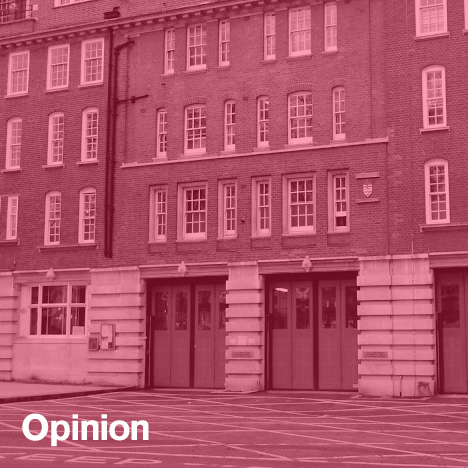
"London's fire station closures represent the inevitable carelessness of contemporary cities"
Opinion: Kieran Long responds to the recent closure of ten London fire stations, arguing that architecture built for a specific purpose and location is far more valuable to a city's sense of place than generic, pragmatic solutions.
Last week in London, ten fire stations serving the city closed for good. The buildings will be sold to the highest bidder and most likely turned into apartments. It felt like a tragedy. These civic places that housed some of the bravest of our citizens were suddenly surplus to requirements and, at a stroke, the men and women who served there had no representation on these high streets.
One striking consequence was the sight of beefcake guys openly weeping on the streets of London. It was as moving as it was unsettling. What kind of a society reduces its strongest and bravest to crying on each others' mountainous shoulders? As the last watch ended at Clerkenwell, Westminster and Belsize stations, emotions ran high. Some anger, yes, which the trade unions stoked as best they could, but mainly resignation and powerlessness: a sense of the inevitable carelessness of contemporary cities.
Architecturally, many of these stations provided a curious setting for this human drama. Take Belsize station in north London, designed by an architect with the unlikely name of Charles Canning Windmill. With its pitched roof and tall dormer windows it has the villagey idiom of the suburban Arts and Crafts. It must have been terribly retro even in 1915 when it was opened, with the gleaming, noisy engines it accommodated seeming jarringly modern against this romantic cottage of a building.
At Clerkenwell station, the built fabric was more urban and assured. Clerkenwell fire station is the oldest in the country (it opened in 1872) and was part of a dense urban fabric even then. Piled on top of and behind the functional, fire engine-related accommodation are flats intended for firefighters and their families. On the roof of this six-storey building is a platform that was used during the war to spot fires as they broke out. There's even a small football pitch for exercise.
To what degree does the architectural character of these fire stations contribute to the guileless sadness expressed by the people who used to work there? Profoundly, I would say. Good architecture marks out our territory; it gives us a place in the world in both literal and metaphorical senses. When that building is built specifically to a purpose that benefits all of us, the sense of loss at its demise is all the greater.
Can we say that the firemen of Clerkenwell felt more sad than those at Kingsland Road, whose building is a fairly banal Modernist box of beige brick and red concertina doors? I'm not sure what kind of quantitative research would be possible on this question, but it's an intriguing problem. When a building articulates its location and purpose so clearly it can be a powerful thing, one that has its own momentum, and some are more powerful than others. Battersea Power Station feels like the most strident example of a building so perfectly suited to its time, place and function, that many have failed to transform it into anything useful since it closed down.
Something happens to the city when you replace the specific with the generic. I've been thinking about this a lot in the last couple of weeks, especially in view of MoMA New York's decision to demolish the Folk Art Museum by Tod Williams and Billie Tsien, which is an egregious example of the sacrifice of the precisely tuned, specific environment with a purposefully generic one.
It is here where the vandalism of that proposal really becomes clear. The Folk Art Museum was intended for a collection of folk art: small, unheroic things that needed low light levels. The galleries helped you concentrate on these objects, but the building also provided a sense of relief through its vertical connections.
MoMA's architect Diller & Scofidio proposes to use the same site for what they call the Art Bay, a large, abstract glass box. In its banal simplicity, it's supposed to enable access for the public and give freedom to artists. In fact, it's a classic misunderstanding of what a public place really is. Taking our place in society is not about being free from constraints, it's about being free enough to commit ourselves to something: understanding our place in relation to others. It's not about flattening or denying our differences by pretending they don't exist, but instead about expressing ourselves clearly and tolerating and enjoying wildly differing approaches to life, culture, art and work.
In her Opinion piece about the MoMA plan on Dezeen, Mimi Zeiger argued that it is somehow sentimental of us to wish for architecture to endure, that it has a sell by date and we should all just accept obsolescence as a fact of contemporary life. In this regard, I think she's wrong. Perhaps bad architecture or arcane, outmoded institutions become obsolete. But good ones adapt, become influenced by their surroundings and renew their commitment to their place in the world. The fire fighters of Clerkenwell were torn away from their place in violent, pragmatic fashion, and it caused pain.
MoMA and institutions like it should be the last to cause such a sense of loss because of pragmatic considerations. Without a sense of institutional and architectural character, our cities would not give us a place in the world. We would all be fire fighters, exiled to a modern, strategically located facility, out of the sight of our fellow citizens: mere service providers.
Kieran Long is senior curator of contemporary architecture, design and digital at the Victoria & Albert Museum. He presents Restoration Home and the series The £100,000 House for the BBC, and is currently the architecture critic for the Evening Standard newspaper.